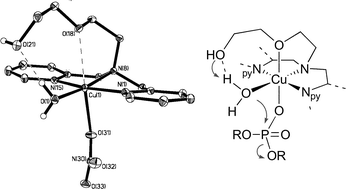Synthesis, structure and comparison of the DNA cleavage ability of metal complexes M(ii)L with the N-(2-ethoxyethanol)-bis(2-picolyl)amine ligand L (M = Co, Ni, Cu and Zn)
Abstract
Complexes of a N,N-bis(2-picolyl)amine (bpa) derivative with a pendant ethoxyethanol side chain (bpa(CH2)2O(CH2)2OH) (1) with late divalent transition metal ions Co(II), Ni(II), Cu(II) and Zn(II) have been studied. All complexes, [{bpa(CH2)2O(CH2)2OH}Co(NO3)](NO3) (1Co), [{bpa(CH2)2O(CH2)2OH}Ni(NO3)](NO3) (1Ni), [{bpa(CH2)2O(CH2)2OH}Cu(H2O)(NO3)](NO3) (1Cu) and [{bpa(CH2)2O(CH2)2OH}Zn(NO3)](NO3) (1Zn), were comprehensively characterized and their X-ray single crystal structures have been determined. The complexes show hexacoordinated geometries, in which 1 acts as a tetradentate (1Cu) or pentadentate (1Co, 1Ni and 1Zn) ligand. DNA cleavage experiments have been performed on supercoiled double stranded DNA plasmids in order to compare the cleavage efficiency of all four metals in the same ligand environment of 1. In this assay, 1Co and 1Cu showed the highest cleavage efficiency, whereas 1Ni and 1Zn were virtually inactive. Quantification of the gel electrophoresis bands showed that more than 80% of the plasmid has suffered at least one single strand cut in the case of 1Cu, and about 50% of the plasmid was nicked by 1Co. The differential cleavage activity is discussed in relation to the structural findings and a mechanism is proposed for 1Cu.


 Please wait while we load your content...
Please wait while we load your content...